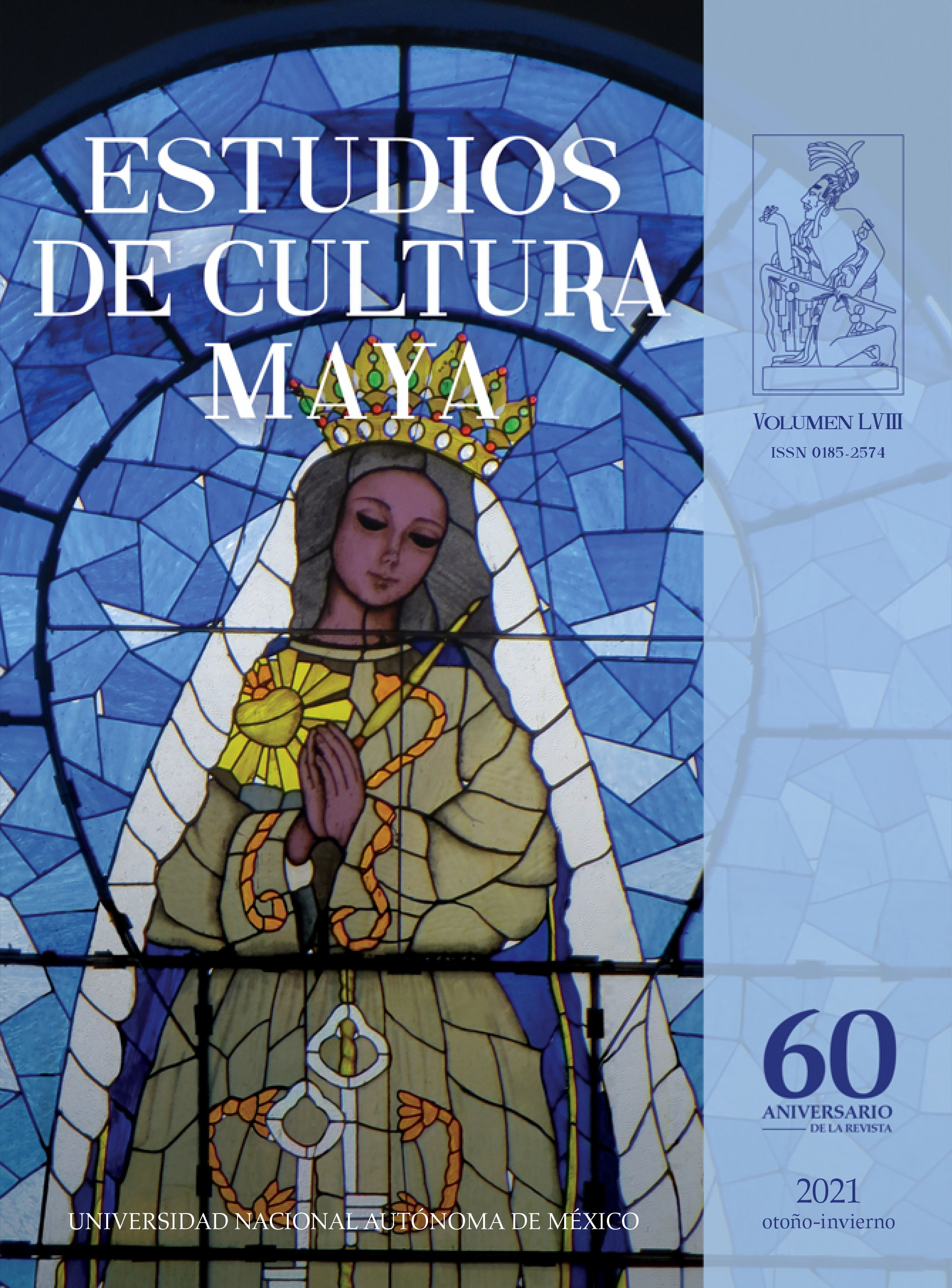The Making of a Plaza: Public Spaces and Marketplaces at Tenam Puente, Chiapas, Mexico
Contenido principal del artículo
Resumen
This study investigates the shifting meanings and practices inscribed on the Main Plaza at the ancient Maya city of Tenam Puente. Plazas are fundamental features of ancient Mesoamerican cities that were important sites for civic activities such as mass spectacles, ceremonies, private rituals, feasting. More recently, certain plazas have also been documented as permanent or periodic marketplaces. New radiocarbon dates and stratigraphic test excavations provide evidence for several important transformations in the built landscape of Tenam Puente’s Main Plaza, including renovations to the site’s principal ballcourt, a large filling and resurfacing event, and a significant addition to the plaza’s volume for the purpose of building a semi-enclosed marketplace plaza. These results provide insight into the evolving nature of public space at the site, from a focus on private rituals and dynastic rule, to an emphasis on mass spectacle, commercial activity, and civic engagement.El presente estudio investiga los cambiantes significados y prácticas inscritas en la Plaza Principal de la antigua ciudad maya de Tenam Puente. Las plazas son elementos arquitectónicos fundamentales en las antiguas ciudades mesoamericanas que fueron sitios importantes para actividades cívicas como espectáculos, ceremonias, rituales privados y banquetes. Más recientemente, ciertas plazas se han documentado como mercados permanentes o periódicos. Nuevas fechas de radiocarbono y pozos estratigráficos aportan evidencias de varias transformaciones importantes en el paisaje urbano de la Plaza Principal de Tenam Puente, incluyendo renovaciones en la cancha del juego de pelota principal del sitio, un gran evento de relleno y repavimentación, y una adición significativa a su volumen con el propósito de construir una plaza de mercado semicerrada. Los resultados proporcionan información sobre el desarrollo del espacio público en el sitio, desde los rituales privados y el reinado dinástico, hasta los espectáculos, actividades comerciales y participación cívica.
Detalles del artículo

Esta obra está bajo una licencia internacional Creative Commons Atribución-NoComercial 4.0.
El autor o autores se compromete(n) a firmar una declaración autorizando la publicación en los distintos soportes y espacios de difusión de Estudios de CulturaMaya y cediendo los derechos patrimoniales sobre la obra en forma total y exclusiva a la Universidad Nacional Autónoma de México, conforme a lo establecido en el artículo 84 de la Ley Federal del Derecho de Autor y demás relativos y aplicables a su reglamento, en el entendido de que será respetado su derecho autoral sobre la obra, se les otorgará el crédito correspondiente y recibirá(n) un ejemplar del número de Estudios donde aparezca el artículo
Citas
Aguilar Rojas, María de la Luz
“La cerámica arqueológica de Tenam Puente,” tesis de maestría en Arqueología. Puebla: Universidad de las Américas.
Álvarez Asomoza, Carlos
El patrón de asentamiento en Las Margaritas, Chiapas. México: Universidad Nacional Autónoma de México, Instituto de Investigaciones Filológicas, Centro de Estudios Mayas.
Anaya Hernández, Armando, Stanley P. Guenter, and Marc U. Zender
“Sak Tz’i’, a Classic Maya Center: A Locational Model Based on GIS and Epigraphy”, Latin American Antiquity, 14 (2): 179-191.
DOI: https://doi.org/10.2307/3557594.
Anaya Hernández, Armando, Kathryn Reese-Taylor, Debra S. Walker, and Nicholas P. Dunning
In press “The Neighborhood Marketplaces of Yaxnohcah”, Archeological Papers of the American Anthropological Association, accepted with revision.
Andrews, George F.
Maya Cities: Placemaking and Urbanization. Norman: University of Utah Press.
Ashmore, Wendy
“Site-Planning Principles and Concepts of Directionality Among the Ancient Maya”, Latin American Antiquity, 2: 199-226. DOI: https://doi.org/10.2307/972169.
Ball, Joseph W.
The Archaeological Ceramics of Chinkultic, Chiapas, Mexico. Provo: Brigham Young University (Papers of the New World Archaeological Foundation, 43).
Barrera Vásquez, Alfredo (dir.)
Diccionario Maya Cordemex: Maya-Español, Español-Maya. Mérida: Ediciones Cordemex.
Becker, Marshall J.
“Ancient Maya Markets: Architectural Grammar and Market Identifications”, The Ancient Maya Marketplace, pp. 90-110, Eleanor M. King (ed.). Tucson: University of Arizona Press.
Becquelin, Pierre, and Eric Taladoire
“Informe de la Cuarta Temporada de Excavaciones en Toniná, Chiapas, 1979”, Estudios de Cultura Maya, 13: 349-371.
Becquelin, Pierre, and Claude F. Baudez
Tonina, Une Cité Maya Du Chiapas. Paris: Mission archéologique et ethnologique française au Mexique (Editions recherche sur les civilisations, Etudes Mésoaméricaines, 4).
Bishop, Ronald L.
“Five Decades of Maya Fine Orange Ceramic Investigation by INAA”, Patterns and Process: A Festschrift in Honor of Dr. Edward V. Sayre, pp. 81-92, Lambertus van Zelst (ed.). Washington: Smithsonian Center for Materials Research and Education.
Blake, Michael
Colonization, Warfare and Exchange at the Postclassic Maya Site of Canajasté, Chiapas, Mexico. Provo: Brigham Young University (Papers of the New World Archaeological Foundation, 70).
Blanton, Richard E., and Lane F. Fargher
How Humans Cooperate: Confronting the Challenges of Collective Action, Boulder: University Press of Colorado.
Blom, Frans, and Oliver La Farge.
Tribes and Temples. New Orleans: Tulane University (MARI Publications 1 and 2).
Bryant, Douglas D.
“Excavations at House 1, Yerba Buena, Chiapas Central Highlands, Mexico”, Archaeology, Ethnohistory, and Ethnoarchaeology in the Maya Highlands of Chiapas, Mexico, Douglas Bryant, Edward Calnek, Thomas A. Lee, and Bryan Hayden (eds.). Provo: Brigham Young University (Papers of the New World Archaeological Foundation, 54-56).
Bryant, Douglas Donne, John E. Clark, and David Cheetham
Ceramic Sequence of the Upper Grijalva Region, Chiapas, Mexico, volume 2. Provo: Brigham Young University (Papers of the New World Archaeological Foundation, 67).
Canuto, Marcello A., James P. Charton, and Ellen E. Bell
“Let No Space Go to Waste: Comparing the Uses of Space Between Two Late Classic Centers in the El Paraíso Valley, Copán, Honduras”, Journal of Archaeological Science, 37 (1): 30-41. DOI: https://doi.org/10.1016/j.jas.2009.08.021.
Cap, Bernadette
“How to Know It When We See It: Marketplace Identification at the Classic Maya Site of Buenavista Del Cayo, Belize”, The Ancient Maya Marketplace, pp. 111-137, Eleanor M. King (ed.). Tucson: University of Arizona Press.
Carrasco, Pedro
“Market and Merchants in the Aztec Economy”, Journal of the Steward Anthropological Society, 11 (2): 249-270.
Carrasco Vargas, Ramón, Verónica A. Vásquez López, and Simon Martin
“Daily Life of the Ancient Maya Recorded on Murals at Calakmul, Mexico”, Proceedings of the National Academy of Science, 106: 19245-19249. DOI: https://doi.org/10.1073/pnas.0904374106.
Casas, fray Bartolomé de las
Apologética Historia. Biblioteca de Autores Españoles, Tomo CVI. Obras Escogidas de Fray Bartolomé de Las Casas, IV. Madrid: Ediciones Atlas.
Chase, Arlen F., Diane Z. Chase, Richard E. Terry, Jacob M. Horlacher, and Adrian S. Chase
“Markets Among the Ancient Maya: The Case of Caracol, Belize”, The Ancient Maya Marketplace, pp. 226-250, Eleanor M. King (ed.). Tucson: University of Arizona Press.
Cheek, Charles D.
“Excavaciones en la Plaza Principal: resumen y conclusiones”, Introducción a la arqueología de Copán, Honduras, pp. 319-48. Tegucigalpa: Secretaría de Estado en el Despacho de Cultura y Turismo (Proyecto Arqueológico Copán, 2).
Chesson, Meredith S.
“Social Memory, Identity, and Death: An Introduction”, Archaeological Papers of the American Anthropological Association, 10 (1): 1-10. DOI: https://doi.org/10.1525/ap3a.2001.10.1.1.
Connerton, Paul
How Societies Remember. Cambridge and New York: Cambridge University Press.
Culbert, T. Patrick
The Ceramic History of the Central Highlands of Chiapas, Mexico. Provo: Brigham Young University.
Dahlin, Bruce H., Daniel Bair, Matthew Moriarty, and Richard Terry
“The Dirt on Food: Ancient Feasts and Markets among the Lowland Maya”, Pre-Columbian Footways: Interdisciplinary Approaches to Food, Culture, and Markets in Ancient Mesoamerica, pp. 191-232, John E. Staller and Michael D. Carrasco (eds.). New York: Springer Science.
Dahlin, Bruce H., Christopher T. Jensen, Richard E. Terry, David R. Wright, and Timothy Beach
“In Search of an Ancient Maya Market”, Latin American Antiquity, 18 (4): 363-384. DOI: https://doi.org/10.2307/25478193.
Deal, Michael
“Household Pottery Disposal in the Maya Highlands: An Ethnoarchaeological Interpretation”, Journal of Anthropological Archaeology, 4: 243-291. DOI: https://doi.org/10.1016/0278-4165(85)90008-X.
De Montmollin, Olivier
a Settlement Survey in the Rosario Valley, Chiapas, Mexico. Provo: Brigham Young University (Papers of the New World Archaeological Foundation, 57).
b The Archaeology of Political Structure: Settlement Analysis in a Classic Maya Polity. Cambridge: Cambridge University Press.
Settlements and Politics in Three Classic Maya Polities. Madison: Prehistory Press (Monographs in World Archaeology, 24).
Díaz del Castillo, Bernal
Historia verdadera de la conquista de la Nueva España. 2 vols. México: Editorial Porrúa.
Doyle, James A.
“Early Maya Geometric Planning Conventions at El Palmar, Guatemala”, Journal of Archaeological Science, 40 (2): 793–798. DOI: https://doi.org/10.1016/j.jas.2012.08.006
Earley, Caitlin C.
“At the Edge of the Maya World: Power, Politics, and Identity in Monuments from the Comitán Valley, Chiapas, Mexico”, PhD Dissertation. Austin: University of Texas.
Eppich, Keith, and David Freidel
“Markets and Marketing in the Classic Maya Lowlands”, The Ancient Maya Marketplace: The Archaeology of Transient Space, pp. 195-225, Eleanor M. King (ed.). Tucson: The University of Arizona Press.
Feldman, Lawrence H.
A Tumpline Economy: Production and Distribution Systems in Sixteenth-Century Eastern Guatemala. Lancaster: Labyrinthos.
Freidel, David A.
“The Political Economics of Residential Dispersion among the Lowland Maya”, Lowland Maya Settlement Patterns, pp. 371-82, Wendy Ashmore (ed.). Albuquerque: University of New Mexico Press, School of American Research.
Freidel, David A., and Linda Schele
“Kingship in the Late Preclassic Maya Lowlands: The Instruments and Places of Ritual Power”, American Anthropologist, 90 (3): 547–567. DOI: https://doi.org/10.1525/aa.1988.90.3.02a00020.
Fulton, Kara A., E. Christian Wells, and Donald A. Storer
“Ritual or Residential? An Integrated Approach to Geochemical Prospection for Understanding the Use of Plaza Spaces at Palmarejo, Honduras”, Archaeological and Anthropological Sciences, 9 (6): 1059-1076. DOI: https://doi.org/10.1007/s12520-013-0170-3.
Haviland, William A.
“Tikal, Guatemala and Mesoamerican Urbanism”, World Archaeology, 2 (2): 186-198. DOI: https://doi.org/10.1080/00438243.1970.9979473.
Hayden, Brian, and Aubrey Cannon
“Where the Garbage Goes: Refuse Disposal in the Maya Highlands”, Journal of Anthropological Archaeology, 2 (2): 117-163. DOI: https://doi.org/10.1016/0278-4165(83)90010-7.
Hendon, Julia A.
“Having and Holding: Storage, Memory, Knowledge, and Social Relations”, American Anthropologist, 102 (1): 42-53. DOI: https://doi.org/10.1525/aa.2000.102.1.42.
Hirth, Kenneth
“Craft Production in a Central Mexican Marketplace”, Ancient Mesoamerica, 20 (1): 89-102.
Hutson, Scott
“Carnival and Contestation in the Aztec Marketplace”, Dialectical Anthropology, 25 (2): 123-149. DOI: https://doi.org/10.1023/A:1011058318062.
Hutson, Scott R., and Richard E. Terry
“Recovering Social and Cultural Dynamics from Plaster Floors: Chemical Analyses at Ancient Chunchucmil, Yucatan, Mexico”, Journal of Archaeological Science, 33 (3): 391-404. DOI: https://doi.org/10.1016/j.jas.2005.08.004.
Iannone, Gyles, and Samuel V. Connell
“Perspectives on Ancient Maya Rural Complexity: An Introduction”, Perspectives on Ancient Maya Rural Complexity, pp. 1-6, Gyles Iannone and Samuel V. Connell (eds.). Los Angeles: University of California (The Cotsen Institute of Archaeology, Monograph 49).
Inomata, Takeshi
“Plazas, Performers, and Spectators: Political Theaters of the Classic Maya”, Current Anthropology, 47 (5): 805-842. DOI: https://doi.org/10.1086/506279.
Inomata, Takeshi, Daniela Triadan, Kazuo Aoyama, Victor Castillo, and Hitoshi Yonenobu
“Early Ceremonial Constructions at Ceibal, Guatemala, and the Origins of Lowland Maya Civilization”, Science, 340 (6131): 467-471. DOI: https://doi.org/10.1126/science.1234493.
Inomata, Takeshi, and Kenichiro Tsukamoto
“Introduction. Gathering in an Open Space: Introduction to Mesoamerican Plazas”, Mesoamerican Plazas: Arenas of Community and Power, pp. 3-18, Takeshi Inomata and Kenichiro Tsukamoto (eds.). Tucson: University of Arizona Press.
Inomata, Takeshi, Daniela Triadan, Verónica A. Vázquez, Juan Carlos Fernandez-Diaz, Takayuki Omori, María Belén Méndez, Melina García, Timothy Beach, Clarissa Cagnato, and Kazuo Aoyama
“Monumental Architecture at Aguada Fénix and the Rise of Maya Civilization”, Nature, 582: 530-533. DOI: https://doi.org/10.1038/s41586-020-2343-4.
Jones, Christopher
“The Marketplace at Tikal”, The Ancient Maya Marketplace, pp. 67-89, Eleanor M. King (ed.). Tucson: University of Arizona Press.
Joyce, Arthur A., Laura A. Bustamente, and Marc N. Levine
“Commoner Power: A Case Study from the Classic Period Collapse on the Oaxaca Coast”, Journal of Archaeological Method and Theory, 8 (4): 343-385. DOI: https://doi.org/10.1023/A:1013786700137.
Joyce, Rosemary A.
“Burying the Dead at Tlatilco: Social Memory and Social Identities”, Archaeological Papers of the American Anthropological Association, 10 (1): 12-26. DOI: https://doi.org/10.1525/ap3a.2001.10.1.12.
Keller, Angela H.
“A Road by Any Other Name: Trails, Paths, and Roads in Maya Language and Thought”, Landscapes of Movement: Trails, Paths, and Roads in Anthropological Perspective, pp. 133-157, James Snead, Clark Erickson, and Andrew Darling (eds.). Philadelphia: University of Pennsylvania Press.
King, Eleanor M.
“The Ethnohistoric Evidence for Maya Markets and Its Archaeological Implications”, The Ancient Maya Marketplace, pp. 33-66, Eleanor M. King (ed.). Tucson: University of Arizona Press.
Kowalski, Jeff Karl
The Mythological Identity of the Figure on the La Esperanza (Chinkultic) Ball Court Maker. Washington: Center for Maya Research (Research Reports on Ancient Maya Writing, 27).
Lalo Jacinto, Gabriel
“Proyecto Arqueológico Tenam Puente,” Informe de la Primera Temporada de Campo 1992-1993. México: Consejo de Arqueología del Instituto Nacional de Antropología e Historia, mecanuscrito.
“Los juegos de pelota en Tenam Puente, Chiapas”, XIV Simposio de Investigaciones Arqueológicas en Guatemala, 2000, pp. 553-563, Juan Pedro Laporte, Ana Claudia Suasnávar, and Bárbara Arroyo (eds.). Guatemala: Museo Nacional de Arqueología y Etnología.
“La arquitectura de Tenam Puente”, Memorias del Tercer Congreso Internacional de Mayistas, volumen II, pp. 406-419. México: Universidad Nacional Autónoma de México, Instituto de Investigaciones Filológicas, Centro de Estudios Mayas, Universidad de Quintana Roo.
“Exploraciones arqueológicas en Tenam Puente, Chiapas”, IV Coloquio Pedro Bosch Gimpera: Arqueología Mexicana, pp. 755-774. Ernesto Vargas (ed.). México: Universidad Nacional Autónoma de México, Instituto de Investigaciones Antropológicas.
Lalo Jacinto, Gabriel, and María de la Luz Aguilar
“El Postclásico Temprano en Tenam Puente”, Quinto Foro de Arqueología de Chiapas, pp. 23-37. Tuxtla Gutiérrez: Gobierno del Estado de Chiapas (Serie Memorias).
Laporte, Juan Pedro, and Jorge E. Chocón
“¿Será un Palacio?... ¡No! ¿Será una Acrópolis?... ¡No!: Un conjunto de función desconcertante en el centro de Pueblito, Petén”, XXI Simposio de Investigaciones Arqueológicas en Guatemala, 2007, pp. 696-712, Juan Pedro Laporte, Bárbara Arroyo, and Héctor Mejía (eds.). Guatemala: Museo Nacional de Arqueología y Etnología.
Latour, Bruno
“On Technical Mediation”, Common Knowledge, 3 (2): 29-64.
Lenkersdorf, Carlos
Tojolabal para principiantes. Lengua y cosmovisión mayas en Chiapas, Mexico City: Plaza y Valdés.
Liendo, Rodrigo, and Francisca Zalaquett
Representaciones y espacios públicos en el área maya: un estudio interdisciplinario. México: Universidad Nacional Autónoma de México.
Lowe, Gareth W.
Archaeological Exploration of the Upper Grijalva River, Chiapas, Mexico. Orinda: New World Archaeological Foundation (Papers of the New World Archaeological Foundation, 2).
Lowe, Lynneth and Carlos Álvarez A.
“Informe preliminar de las exploraciones realizadas en el sitio Cimientos de Las Margaritas, Chiapas, Segunda Temporada (1995),” Memorias del Tercer Congreso Internacional de Mayistas, volumen II, pp. 429-443. Mexico: Universidad Nacional Autónoma de México, Universidad de Quintana Roo.
Marcus, Joyce
“The Nature of the Mesoamerican City”, Prehistoric Settlement Patterns: Essays in Honor of Gordon R. Willey, pp. 195-242, Evan Z. Vogt and Richard M. Leventhal (eds.). Albuquerque: University of New Mexico Press.
“From Centralized Systems to City-States: Possible Models for the Epiclassic”, Mesoamerica After the Decline of Teotihuacan A.D. 700-900, pp. 201-208, Richard A. Diehl and Janet Catherine Berlo (eds.). Washington: Dumbarton Oaks Research Library and Collection.
Martin, Simon, and Nikolai Grube
Chronicle of the Maya Kings and Queens: Deciphering the Dynasties of the Ancient Maya. London: Thames and Hudson.
Masson, Marilyn A., and David A. Freidel
“An Argument for Classic Era Maya Market Exchange”, Journal of Anthropological Archaeology, 31: 455–484. DOI: https://doi.org/10.1016/j.jaa.2012.03.007.
Masson, Marilyn, and Carlos Peraza Lope
Kukulkan’s Realm: Urban Life at Ancient Mayapán. Boulder: University Press of Colorado.
Maxwell, David
“Beyond Maritime Symbolism: Toxic Marine Objects from Ritual Contexts at Tikal”, Ancient Mesoamerica, 11: 91-98.
McAnany, Patricia A.
Living with the Ancestors: Kinship and Kingship in Ancient Maya Society. Austin: University of Texas Press.
Ancestral Maya Economies in Archaeological Perspective. Cambridge: Cambridge University Press.
Morley, Sylvanus G.
The Inscriptions of Peten. 5 Vols. Washington: Carnegie Institution of Washington (Publication No. 16).
Navarrete, Carlos
Guia para el estudio de los monumentos esculpidos de Chinkultic, Chiapas, México. Mexico: Universidad Nacional Autónoma de Mexico.
“El complejo escénico de Chinkultic, Chiapas”, XX Simposio de Investigaciones Arqueológicas en Guatemala, pp. 987-1006, Juan Pedro Laporte, Barbara Arroyo, and Héctor Mejía (eds.). Guatemala: Museo Nacional de Arqueología y Etnología.
Neff, Hector
“Pots as Signals: Explaining the Enigma of Long-Distance Ceramic Exchange”, Craft and Science: International Perspectives on Archaeological Ceramics, pp. 1-11, Marcos Martinón-Torres (ed.). Doha: Bloomsbury Qatar Foundation (UCL Qatar Series in Archaeology and Cultural Heritage).
Neff, Hector, and Ronald L. Bishop
“Plumbate Origins and Development”, American Antiquity, 53 (3): 505–522. DOI: https://doi.org/10.2307/281214.
Ossa, Alanna, Michael E. Smith, and José Lobo
“The Size of Plazas in Mesoamerican Cities and Towns: A Quantitative Analysis”, Latin American Antiquity, 28 (4): 457-475. DOI: https://doi.org/10.1017/laq.2017.49.
Paris, Elizabeth H.
“Political Economy on the Postclassic Western Maya Frontier”, Ph.D. dissertation. Albany: University at Albany, SUNY.
Paris, Elizabeth H., Eric Taladoire, and Thomas A. Lee Jr.
“Return to Moxviquil: Form and Function in a Small Maya City”, Ancient Mesoamerica, 26 (1): 81–112. DOI: https://doi.org/10.1017/S0956536115000048.
Paris, Elizabeth H., and Roberto López Bravo
“Los mayas de los Altos de Chiapas y sus vecinos occidentales: interacción, identidad e intercambio en una frontera cultural”, Estudios de Cultura Maya, 49: 39-66. DOI: https://doi.org/10.19130/iifl.ecm.2017.49.765
“Gulf Coast Influence at Moxviquil, Chiapas, Mexico”, Cambridge Archaeological Journal, 30 (2): 1-17. DOI: https://doi.org/10.1017/S0959774319000465.
Paris, Elizabeth H., Roberto López Bravo, and Gabriel Lalo Jacinto
“An Archaic Period Stemmed and Barbed Point from Tenam Puente, Chiapas, Mexico”, Arqueología Iberoamericana, 43: 62-66.
Parrott, Nathan D.
n.d. “Sakjol: An Ancient Maya Neighborhood Marketplace at Yaxnohcah”, M. A. thesis. Calgary: University of Calgary.
Proskouriakoff, Tatiana
A Study of Classic Maya Sculpture. Washington: Carnegie Institution of Washington (Publication No. 593).
Rapoport, Amos
The Meaning of the Built Environment. London: Sage.
Ringle, William M., and George J. Bey III
“Post-Classic and Terminal Classic Courts of the Northern Maya Lowlands”, Royal Courts of the Ancient Maya: Data and Case Studies, volume 2, pp. 266-307, Takeshi Inomata and Stephen D. Houston (eds.). Boulder: Westview Press.
Rivero Torres, Sonia E.
“Los Cimientos: análisis del patrón de asentamiento,” tesis de licenciatura en Arqueología. México: Escuela Nacional de Antropología e Historia.
Los Cimientos, Chiapas, Mexico: A Late Classic Maya Community. Provo, UT: Brigham Young University (Papers of the New World Archaeological Foundation, 51).
Patrón de asentamiento rural en la región de San Gregorio, Chiapas, para el Clasico Tardío. Mexico: Instituto Nacional de Antropología e Historia (Coleccion Científica, Serie Arqueología).
Robin, Cynthia
Everyday Life Matters: Maya Farmers at Chan. Gainesville: University Press of Florida.
Sahagún, fray Bernardino de
Book 9. The Merchants. Santa Fe: Monographs of the New School of American Research and the Museum of New Mexico.
Schele, Linda, and Mary Ellen Miller
Blood of Kings: Dynasty and Ritual in Maya Art. New York and Fort Worth: Goerge Braziller and Kimbell Art Museum.
Schwake, Sonja A., and Gyles Iannone
“Ritual Remains and Collective Memory: Maya Examples from West Central Belize”, Ancient Mesoamerica, 21 (2): 331–339. DOI: https://doi.org/10.1017/S0956536110000283.
Scott, James C.
Domination and the Arts of Resistance: Hidden Transcripts. New Haven: Yale University Press.
Seler, Eduard
Die Alten Ansiedelungen von Chacula in Distrikte Nenton Des Departamente Huehuetenango Der Republik Guatemala. Berlin: Dietrich Reimer (E. Vohsen).
Shaw, Leslie C.
“The Elusive Maya Marketplace: An Archaeological Consideration of the Evidence”, Journal of Archaeological Research, 20 (2): 117-155. DOI: https://doi.org/10.1007/s10814-011-9055-0.
Smith, Michael E.
“City Size in Late Postclassic Mesoamerica”, Journal of Urban History, 31: 403-434. DOI: https://doi.org/10.1177/0096144204274396
Aztec City-State Capitals. Tallahasse: University Press of Florida.
Smith, Michael E., and Frances F. Berdan
“Spatial Structure of the Mesoamerican World System”, The Postclassic Mesoamerican World, pp. 21-31, Michael E. Smith and Frances F. Berdan (eds.). Salt Lake City: University of Utah Press.
Smith, Robert E.
“The Place of Fine Orange Pottery in Mesoamerican Archaeology”, American Antiquity, 24 (2): 151-60. DOI: https://doi.org/10.2307/277476.
Speal, C. Scott
“The Evolution of Ancient Maya Exchange Systems: An Etymological Study of Economic Vocabulary in the Mayan Language Family”, Ancient Mesoamerica, 25 (1): 69–113. DOI: https://doi.org/10.1017/S0956536114000078.
Stark, Barbara L., and Alanna Ossa
“Origins and Development of Mesoamerican Marketplaces: Evidence from South-Central Veracruz, Mexico”, Archaeological Approaches to Market Exchange in Ancient Societies, pp. 99-126, Christopher P. Garraty and Barbara L. Stark (eds.). Boulder: University Press of Colorado.
Taladoire, Eric
“Las bases económicas de una entidad política maya. El caso de Toniná”, Estudios de Cultura Maya, 48: 11-37. DOI: http://dx.doi.org/10.19130/iifl.ecm.2016.48.753.
Terry, Richard E., Daniel A. Bair, and Eric G. Coronel
“Soil Chemistry in the Search for Ancient Maya Marketplaces”, The Ancient Maya Marketplace, pp. 138-67, Eleanor M. King (ed.). Tucson: University of Arizona Press.
Tokovinine, Alexandre, and Dmitri Beliaev
“People of the Road: Traders and Travelers in Ancient Maya Words and Images”, Merchants, Markets, and Exchange in the Pre-Columbian World, pp. 169-200, Kenneth G. Hirth and Joanne Pillsbury (eds.). Washington: Dumbarton Oaks Research Library and Collection.
Tourtellot, Gair
Excavations at Seibal, Department of Peten, Guatemala: Peripheral Survey and Excavation, Settlement and Community Patterns. Cambridge: Peabody Museum of Archaeology and Ethnology (Memoirs of the Peabody Museum of Archaeology and Ethnology, 16).
Traxler, Loa P.
“Redesigning Copan: Early Architecture of the Polity Center”, Understanding Early Classic Copan, pp. 53-64, Ellen E. Bell, Marcello A. Canuto, and Robert J. Sharer (eds.). Philadelphia: University of Pennsylvania Museum of Archaeology and Anthropology.
Ximénez, fray Francisco
Historia de la provincia de San Vicente de Chiapa y Guatemala. Guatemala: La Tipografia Nacional.
Zúñiga Arellano, Belem
“Evidencias arqueológicas del uso de la fauna en Palenque y Tenam Puente, Chiapas”, El Territorio Maya: Memoria de la Quinta Mesa Redonda de Palenque, pp. 41-67, Rodrigo Liendo Stuardo (ed.). México: Instituto Nacional de Antropología e Historia (Cuadernos CICOSUL, Serie Mesas Redondas).






